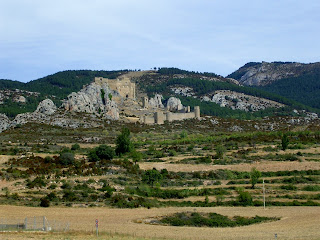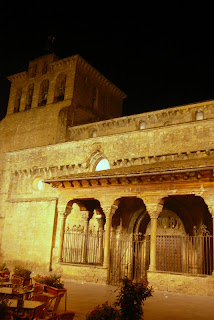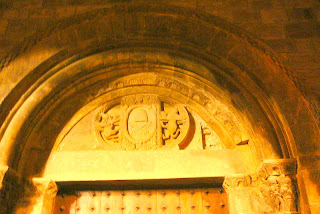This monastery is on the Way of St. James, the Camino de Santiago,medieval and current pilgrimage route with many branches converging at Spain's Santiago de Compostela. It is constructed under a large cliff overhang. The old Mozerabic chapel dates from 920 AD. Mozerabs: Iberian or Spanish peninsula Christians who lived under Moorish rule in the then Al-Andalus. They never converted to Islam, but did absorb some customs and spoke Arabic. Origins: Hispano-Gothic, and some northern European Christians, as well as Arab and Berber. Fine little video of the area is here: Peregrina Rosina's work at http://www.youtube.com/watch?v=pXjeRnnCslk
Under Sharia law, Jews and Christians lived among the Arab Muslims but had special "dhimmi" status rules -- taxes, some restrictions, lower status, but lived safely. We can learn from some era's interpretations of Sharia.
End of day brings beautiful lighting. The Holy Grail is said to have been kept there, as the faithful fled the Moors, see account that stories produce, at http://thespiralofknowledge.com/dossier.cfm?lang=en&id=49.
Holy Land, to Huesca, and then circuitous protection route beginning in the 8th Century with the Moorish invasions, with, some say, final arrival at Valencia.
Start at the foot of Mount Pano, above the old town church, Santa Cruz de la Seros, and up the mountain. The cliff monastery, San Juan de la Pena, is in two parts -- the older cliff monastery, and a newer and large one at the flat summit.
There are other traditions or origins, in addition to the Holy Grail at San Juan de la Pena, see http://www.hikepyrenees.co.uk/san-juan-de-la-pena.html. It is said that a nobleman was hunting, chased a stag who leaped off a cliff, the nobleman and his horse followed. The nobleman prayed for deliverance on the way down. Sure enough, he landed at a cave, found a hermit's bones inside, and gave thanks and built the monastery. San Juan: Saint John. Which?
..............................................................
Route note: after Roncesvalles, the logical next stop would Pamplona. We had already seen the bulls running there, so took the bypass. Pamplona: see http://spainroadways.blogspot.com/2008/02/pamplona-bulls.html/
 San Juan de la Pena, Monastery, Spain
San Juan de la Pena, Monastery, Spain San Juan de la Pena, cliff monastery, Spain
San Juan de la Pena, cliff monastery, Spain San Juan de la Pena, facade, old cliff monastery
San Juan de la Pena, facade, old cliff monastery San Juan de la Pena, Spain. Mozerabic monastery.
San Juan de la Pena, Spain. Mozerabic monastery. San Juan de la Pena, view of Pyrenees, access road, Spain
San Juan de la Pena, view of Pyrenees, access road, Spain San Juan de la Pena, access road up mountain, Spain
San Juan de la Pena, access road up mountain, Spain San Juan de la Pena, cliffton view of Pyrenees, Spain
San Juan de la Pena, cliffton view of Pyrenees, Spain San Juan de la Pena, new monastery 1675, Spain
San Juan de la Pena, new monastery 1675, Spain San Juan de la Pena, new monastery grounds, Spain
San Juan de la Pena, new monastery grounds, Spain Old San Juan de la Pena, monastery, Spain
Old San Juan de la Pena, monastery, Spain Castle Loarre, Loarre, Spain
Castle Loarre, Loarre, Spain Castle Loarre, Access path, Spain
Castle Loarre, Access path, Spain Loarre Castle, Queen's Chapel, Spain; original alabaster window (thin, transparent stone); Romanesque capital with leaves, horsemen?
Loarre Castle, Queen's Chapel, Spain; original alabaster window (thin, transparent stone); Romanesque capital with leaves, horsemen? Loarre Castle, Queen's Chapel, Spain sunset window and capitals
Loarre Castle, Queen's Chapel, Spain sunset window and capitals Loarre Castle, Queen's Chapel, Spain; capital, rosette design, seated figures,
Loarre Castle, Queen's Chapel, Spain; capital, rosette design, seated figures, Loarre Castle Church of San Pedro, capital, fish, river, reeds, hearts? Is that a papyrus? Is this Moses??
Loarre Castle Church of San Pedro, capital, fish, river, reeds, hearts? Is that a papyrus? Is this Moses?? Loarre Castle, capital in Queen's Chapel, Daniel in lion's den?
Loarre Castle, capital in Queen's Chapel, Daniel in lion's den? Madonna and child, Loarre Castle sculpture, Queen's Chapel, Loarre Castle, Spain.
Madonna and child, Loarre Castle sculpture, Queen's Chapel, Loarre Castle, Spain.  Loarre Castle, Capital, Queen's Chapel, angel with wonderful wings
Loarre Castle, Capital, Queen's Chapel, angel with wonderful wings Queen's Chapel, Loarre Castle, Capital, Celtic-type basketweave capital, from Visigoth influence? Spain
Queen's Chapel, Loarre Castle, Capital, Celtic-type basketweave capital, from Visigoth influence? Spain Saint Luke with the Eagle? Loarre Castle, Queen's Chapel, Spain
Saint Luke with the Eagle? Loarre Castle, Queen's Chapel, Spain Queen's Chapel, Loarre Castle, Spain. Uneasy lies the crowned head? Whose?
Queen's Chapel, Loarre Castle, Spain. Uneasy lies the crowned head? Whose? Loarre Castle, Queen's Chapel, scary tangle Capital, Spain
Loarre Castle, Queen's Chapel, scary tangle Capital, Spain Loarre Castle, near Jaca, Spain. Distance view from flatland side.
Loarre Castle, near Jaca, Spain. Distance view from flatland side. Loarre Castle, Spain, distance view, castle emerging from the cliff rock. Also near Huesca.
Loarre Castle, Spain, distance view, castle emerging from the cliff rock. Also near Huesca.  Castellan's Tower, Loarre Castle, Spain
Castellan's Tower, Loarre Castle, Spain Castillo de Loarre, Huesca Province, Spain. Monastery complex tower, Augustinian, 1064 or so.
Castillo de Loarre, Huesca Province, Spain. Monastery complex tower, Augustinian, 1064 or so. Interior Courtyard, Loarre Castle, Spain
Interior Courtyard, Loarre Castle, Spain Pilgrim, Camino de Santiago, Way of Saint James, to Santiago de Compostela from Roncesvalles, Spain
Pilgrim, Camino de Santiago, Way of Saint James, to Santiago de Compostela from Roncesvalles, Spain Pilgrim, To Santiago de Compostela, Spain, from near Roncesvalles..
Pilgrim, To Santiago de Compostela, Spain, from near Roncesvalles.. cc
cc Pilgrim making progress; to Santiago de Compostela from Roncesvalles.
Pilgrim making progress; to Santiago de Compostela from Roncesvalles. Marker, Saint James Way, Santiago de Compostela pilgrim route, near Jaca
Marker, Saint James Way, Santiago de Compostela pilgrim route, near Jaca Saint James' Way.: Between Roncesvalles and Jaca, 760 km to Santiago de Compostela
Saint James' Way.: Between Roncesvalles and Jaca, 760 km to Santiago de Compostela Scallop marker, Way of St. James, to Santiago de Compostela, near Roncesvalles, toward Jaca, Spain.
Scallop marker, Way of St. James, to Santiago de Compostela, near Roncesvalles, toward Jaca, Spain. Citadel, Castillo de San Pedro, Jaca, Spain
Citadel, Castillo de San Pedro, Jaca, Spain Composite Coat of Arms, Jaca, Spain. Castillo de San Pedro
Composite Coat of Arms, Jaca, Spain. Castillo de San Pedro Plaque, La Ciudadela, Castillo de San Pedrol Jaca, Spain
Plaque, La Ciudadela, Castillo de San Pedrol Jaca, Spain Hotel Nieu, Jaca, Spain. Family-run, spotless, friendly, good food.
Hotel Nieu, Jaca, Spain. Family-run, spotless, friendly, good food.  A Militant Mary, or something else? La Couvertoirade, Church, France.
A Militant Mary, or something else? La Couvertoirade, Church, France. Jaca Cathedral, Jaca, Spain. Night view.
Jaca Cathedral, Jaca, Spain. Night view. Pub near Jaca Cathedral, Jaca Spain
Pub near Jaca Cathedral, Jaca Spain Cathedral at Jaca, side entrance loggia or open room
Cathedral at Jaca, side entrance loggia or open room qq
qq Catedral de San Pedro Apostal, Jaca, Spain. Coat of arms, doorway
Catedral de San Pedro Apostal, Jaca, Spain. Coat of arms, doorway Jaca Cathedral, interior columns showing differing styles
Jaca Cathedral, interior columns showing differing styles Small capital, Romanesque, St. Peter the Apostle, Cathedral, Jaca
Small capital, Romanesque, St. Peter the Apostle, Cathedral, Jaca Interior, Cathedral at Jaca, Jaca, Spain
Interior, Cathedral at Jaca, Jaca, Spain Renaissance renovations, Cathedral at Jaca, Jaca, Spain
Renaissance renovations, Cathedral at Jaca, Jaca, Spain Belfry, Jaca, Spain. Not the Cathedral. What?
Belfry, Jaca, Spain. Not the Cathedral. What? Building contemporary with Cathedral? Wall-spotting, Jaca, Spain.
Building contemporary with Cathedral? Wall-spotting, Jaca, Spain.